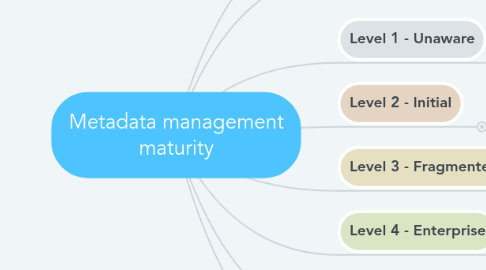
1. What is metadata?
1.1. Short: data about data
1.2. Long: information about one or more aspects of the data. It can also summarize some basic information and provide additional insight into the characteristics of the data described.
1.3. Can include
1.3.1. Names
1.3.2. Descriptions
1.3.3. Definitions
1.3.4. Meaning & purpose
1.3.5. Classifications
1.3.5.1. Data types / classes
1.3.5.2. Privacy
1.3.6. Ownership / role / access information
1.3.7. Relationships to other data
1.3.8. Version
1.3.9. Location
1.3.10. Technical attributes
1.3.11. Quality scores & attributes
2. Metadata management (mm)
2.1. Emerged as an answer to exponential data explosion
2.2. Benefits of MM
2.2.1. Increased trust in data
2.2.2. Better compliance, capabilities to meet modern data & privacy regulations
2.2.3. Increased security at lower costs
2.2.4. Well-defined roles and responsibilities in relation to data assets
2.2.5. Lower costs and increased agility for any data-related disciplines
2.2.5.1. Engineering
2.2.5.2. Data science
2.2.5.3. Analytics
2.2.6. Improved capabilities for impact analysis
3. Level 1 - Unaware
3.1. There is no awareness of metadata management as a discipline
3.2. The vast majority of businesses a decade ago were at this stage
3.3. Metadata organized sporadically if at all
4. Level 2 - Initial
4.1. Some awareness of metadata management
4.2. Getting to know basic concepts
4.3. No centralized approach to metadata management
4.4. May use existing tools and platforms to identify collect, organize and maintain metadata
4.4.1. Spreadsheets
4.4.2. Documents
4.4.3. Wiki pages
4.4.4. Databases
5. Level 3 - Fragmented
5.1. Recognition of importance of metadata management, but efforts are fragmented
5.2. No common enterprise posture
5.3. Likely multiple metadata repositories with different formats
5.4. Policies and guidelines might exist on local level
5.5. Likely no enterprise-level data governance program
5.6. Possible introduction of automation for metadata scraping
5.7. Possible introduction of metadata quality measurement
6. Level 4 - Enterprise
6.1. Recognition of importance of metadata management on the highest level in the organization
6.2. Likely, there is a Chief Data Officer or an equivalent role, and an enterprise-level data management team
6.3. Policy and tool adoption are enterprise-wide
6.4. Metadata is managed in a centralized fashion
6.4.1. Federated approaches also possible with standardization
